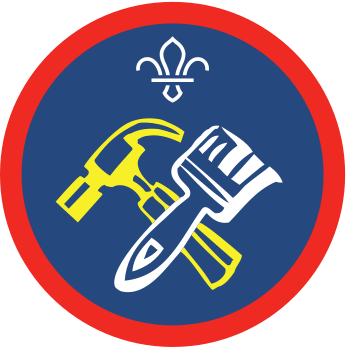Wall of art
You’ll need
- Pens or pencils
- Scrap paper
- Suitable paint
- Paintbrushes and rollers, in suitable sizes
- White spirit for oil-based paints
- Dust sheets and old newspaper
- Paint trays
- Plastic tubs filled with water, in suitable sizes
- Suitable PPE (personal protective equipment), where needed
- Step-stool, where needed
- Cleaning equipment
Time to get creative
- You may decide to run this activity across two sessions. A design for the wall could be finalised in the first session and the painting completed in the second. Additional prep time may also be required, where an undercoat or wallpaper-stripping is needed, for instance.
- Get express permission from the building owner to paint the wall, and let them know your plans.
- Carry out a full and comprehensive risk assessment on all aspects of the activity, looking at information about working at heights if using a step-stool. Advice on COSHH (Control of Substances Hazardous to Health) will also need to be sought regarding paints, sealants, cleaners and other substances used. Have a look at this page on managing premises for more information.
- If you’re not able to paint your meeting place for whatever reason, see if you can carry out this activity somewhere else locally. Head over to Help others to find information on running community impact projects.
Choosing and preparing your canvas
- Get everybody together and discuss painting a wall of the meeting place, in a style that reflects what the group’s like or shows what the local community is like. Choose a suitable wall that’s not used for anything else and can be painted in one session. Everyone should start to think about what they’d like to see up on the wall.
- Young people may be able to help prepare the wall for painting, where the risks have been assessed. Move any furniture, shelving or pictures attached to or up against the wall in question. If there’s old wallpaper, strip it away and wipe down the wall with warm, soapy water. Once it’s dry and clean, the wall may need an undercoat before it’s ready for painting.
- When you’re ready to start painting, put out dust sheets and newspaper on the floor and over nearby objects to protect them. Anyone painting needs to be wearing old clothes they don’t mind getting paint on.
Plan your design
- Everyone should get into small groups to discuss their design ideas before opening any paint. Have everyone combine their ideas into one big mural, or section off the wall and have each group design a portion together.
- Gather the equipment needed to start the painting
Paintbrushes at the ready
- If the design is complex, consider drawing an outline onto the wall and using this as a guide when painting. You could also use a projector to show more complicated logos and patterns.
- Get painting! Try to paint lighter colours first, and allow them to dry before using a different colour close by. Make sure windows are open to ventilate the room, everything’s as tidy as possible and that everybody is taking regular breaks. Everyone should take their time and paint with care, as they can always come back later to finish the job.
- When the job is complete, apply a clear, fire-retardant sealant to the wall to protect the work.
Reflection
The group chose a wall, came up with a design and painted their design. This design needed to reflect something about the group or about the local community. How did everyone work together with these instructions to create a design that everyone liked and that was representative of the group/area? What impact might your design have on someone who’s new to the group or to the community?
Safety
All activities must be safely managed. You must complete a thorough risk assessment and take appropriate steps to reduce risk. Use the safety checklist to help you plan and risk assess your activity. Always get approval for the activity, and have suitable supervision and an InTouch process.
- Heavy and awkward objects
Never lift or move heavy or awkward items alone. Ask for help or, if possible, break them down into smaller parts.
- Glue and solvents
Always supervise young people appropriately when they’re using glue and solvent products. Make sure there’s plenty of ventilation. Be aware of any medical conditions that could be affected by glue or solvent use and make adjustments as needed.
- Chemicals
This task involves the use of potentially harmful fluids or chemicals. Make sure you follow all relevant safety guidance. Make sure you dispose of them appropriately too, in line with safety guidance.
Extra painting techniques that could be included for a more rounded challenge include using different size and shape brushes and rollers, masking off skirting boards and lintels with newspaper and painting with stencils.
Gloves should be available for those with sensitive skin or those that want them.
Make sure all equipment is placed at a suitable height for everyone taking part to reach.
All Scout activities should be inclusive and accessible.
Publicise your paint-job and invite other local groups to show off their skills with a brush. Displaying all the great things about your community is a wonderful way to remind everyone to take pride in where they live.
Young people chose the wall, designed the picture and painted it. See if they’ll encourage others to do the same to express themselves!



